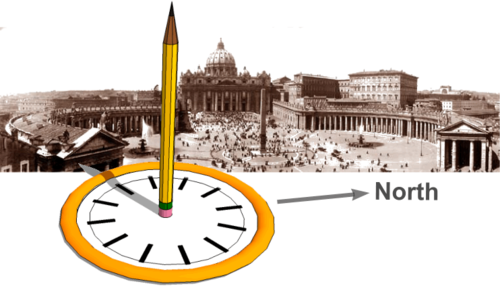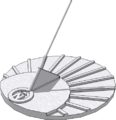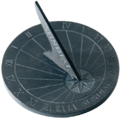Category:Sundials
From DT Online
Introduction
Sundials (aka Shadow Clocks) are perhaps the oldest known scientific instrument. The sun's shadow cast by any object, and especially a tall tree or a stick in the ground, would from the earliest times have illustrated the apparent movement of the Sun around the Earth (‘apparent’ because as we have known at least since the days of Copernicus that it is the Earth that moves around the Sun)
The Ancient Egyptians erected tall Obelisks, often in pairs, at the entrance to temples, It is believed they were erected to celebrate their Sun God Ra and the tops of some were covered in Electrum which would certainly reflect the Sun's rays . They may have indicated key points of the day (e.g. sunrise, sunset, noon) and of the year (e.g. the summer or winter Solstice) but it was the Romans who developed the idea of Sundials (e.g. an Obelisk originally erected at Heliopolis in the seventh century B.C. was brought to Rome in 10 B.C. by Augustus and set up in the Campus Martius where it was used as the Gnomon (or ‘needle’) of the Horologium, a great sundial and calendar. It was transferred to Rome in 37 AD and finally erected in St Peter's Square, Rome in 1586, where it remains to this day)
Pages in category 'Sundials'
The following 12 pages are in this category, out of 12 total.
Media in category 'Sundials'
The following 18 files are in this category, out of 18 total.
- AluminiumSundialProject.png 474 × 489; 129 KB
- Armillary-pas-sml-01-600.png 589 × 472; 250 KB
- HorizontalSundial.png 509 × 365; 23 KB
- HorizontalSundialEG.png 500 × 495; 269 KB
- Merkhet.png 470 × 99; 47 KB
- PolarSundial2.png 347 × 235; 33 KB
- PolarSundial3.png 687 × 623; 40 KB
- StPetersSquare.png 742 × 424; 90 KB
- StripwoodSundialModel.png 1,055 × 354; 40 KB
- Sundial7.png 754 × 533; 76 KB
- SundialModelPreparation.png 1,104 × 381; 34 KB
- SundialModelSettingOut.png 1,067 × 256; 41 KB
- SundialProjectDevelopment.png 1,134 × 548; 95 KB
- SundialProjectIdeas.png 1,113 × 387; 108 KB
- SunShadows.png 918 × 425; 40 KB
- VerticalSundial.png 533 × 356; 29 KB
- VerticalSunDial3.png 415 × 269; 54 KB
- VerticalSundialEG.png 904 × 1,289; 887 KB













